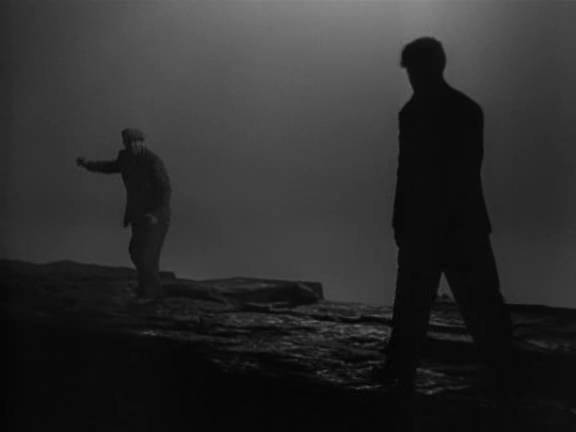
I am afraid that film buffs like me are the reason that moody little romantic melodramas like Moontide (1942) are being marketed as "film noir" although they don't fit that label historically nor thematically, especially since it arrives two years before Double Indemnity, when the form really announced and defined itself.
But as much of noir buff as I am, I sought Moontide out because of a new interest in Ida Lupino and an abiding affection for the work of Jean Gabin, who to me incorporates the tough and tender combination of Spencer Tracy and Humphrey Bogart, plus a foreshadowing of Belmondo and an ineffable something of his own. Gabin was one of the few actors who looked the men he played, men who worked with their hands for a living and were given to violence, yet had some poetry in their souls--a man both men and women felt drawn to.
Whereas film noir's subject matter comes from the American hard-boiled detective genre as exemplified by Hammett and Chandler, and which in turn is derived from Hemingway; Moontide seems to connect to early realists like Zola, Gorky or Norris.
Ways in which Moontide resembles film noir:
- Extraordinary Oscar-nominated low-key photography credited to Charles G. Clarke (who has no noir credits) with, reportedly, an uncredited assist by Lucien Ballard, who worked on The Lodger, Laura and The Killing to name just a few in a longer and more distinguished career than Clarke's;
- Low-down, waterfront atmosphere with much night and fog;
- Crime-haunted characters;
- A protagonist given to drinking, violence and black-outs, yet a poetic sensibility, too;
- The hero makes a terrible error in judgment with dire consequences (i.e., leaving his bride alone on their wedding night to be attacked by...)
- A treacherous friend who betrays the hero; and
- A hard-boiled heroine, probably once a "working girl"
- Although supposedly set in San Pedro, lacks a clear American flavor, being completely studio-bound, with a quasi-European never-never land feeling;
- Lack of an urban setting--this is not fatal, as in Out of the Past, but it detracts from a real noir flavor.
- No sense of the past coming back to rule the lives of the characters,, in fact little reflection of the effect of time on the character's lives;
- Little hard-boiled quality at all (other than Ida Lupino's persona), only one crime, and that either of passion or inadvertence, no police, no detectives;
- Little sense of fatality flowing from the hero's mistakes or flaws, and the hero is never a fall guy, despite his friend Tiny's efforts to make him one;
- No femme fatale--sexuality generally kept on a low burner;
- Little sense of concealment of forbidden thoughts or actions;
- the inconclusiveness and weak humor of Claude Rains' character, who seems to be an observer, but makes no interesting observations;
- Other than Lupino, few noir-style actors; much as I love Thomas Mitchell, his earnestness is wrong for noir and he is miscast in this role; and
- a hopeful, positive ending





No comments:
Post a Comment